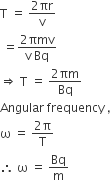 Short Answer Type
Short Answer TypeA circular coil of cross-sectional area 200 cm2 and 20 turns is rotated about the vertical diameter with angular speed of 50 rad s−1 in a uniform magnetic field of magnitude 3.0 × 10−2T. Calculate the maximum value of the current in the coil.
A wire whose cross-sectional area is increasing linearly from its one end to the other, is connected across a battery of V volts.
Which of the following quantities remain constant in the wire?
(a) drift speed
(b) current density
(c) electric current
(d) electric field
Define the distance of closest approach. A α-particle of kinetic energy 'K' is bombarded on a thin gold foil. The distance of the closest approach is 'r'. What will be the distance of closest approach for a α-particle of double the kinetic energy?
Which basic mode of communication is used in satellite communication? What type of wave propagation is used in this mode? Write, giving a reason, the frequency range used in this mode of propagation.
(i) Obtain the expression for the cyclotron frequency.
(ii) A deuteron and a proton are accelerated by the cyclotron. Can both be accelerated with the same oscillator frequency? Give reason to justify your answer.
When a charged particle (q) moves inside a magnetic field B with velocity v, it experiences a force F = q(v xB) when v is perpendicular to B, the force F on the charged acts as the centripetal force and makes it move along a circular path.
Let m be the mass of particle and r is radius of circular path
Time period of the circular motion of a charged particle is given by
ii) No, The mass of the two particles, i.e deuteron and proton, is different.Since (cyclotron) frequency depends inversely on the mass, they cannot be accelerated by the same oscillator frequency.
